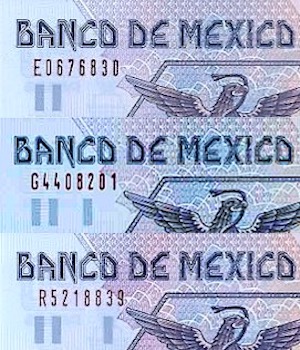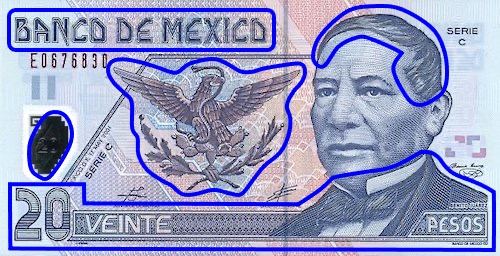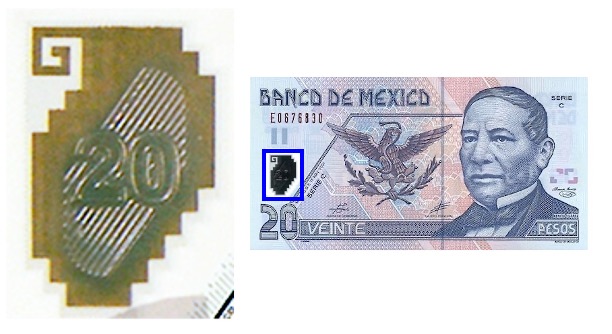Eighth emission
(printed by el Banco de México)
This emission, launched into circulation on October 1, 2002, even if it only contains the denomination of 20 pesos, can be considered as a different issue from the previous one and for this reason it begins again with series A. The concept of "paper money" changes completely in this series of banknotes issued by the Bank of Mexico (from 2001 to date): for the first time, paper money is no longer printed on paper, but on polymer.
The banknote of 20 pesos, being the lowest denomination, changes quickly of hands and thus causes faster deterioration than other denominations (average 6 months). Several countries that have experienced similar problems have solved it by printing their banknotes on plastic.
This change was considered provisional at first and was intended to determine if Mexico was able to increase the life of banknotes similar to what was achieved in other countries (life increased up to four times).
Part of the issue was printed in Australia by Note Printing Australia (NPA) and part was printed in Mexico by the Printing Works of Banco de Mexico using polymer sheets supplied by Securency, the joint venture between the Reserve Bank of Australia and UCB of Belgium.
This was not a concurrent process. Mexican officials attended NPA to participate in the Australian printing and to learn the intricacies of printing on polymer. Upon conclusion of this process, thought to be about December 2001, the completed notes were shipped to Mexico. Australian technicians then travelled to Mexico to assist in the printing of the second run of notes at the Banco de Mexico Printing Works and all future printing was done in Mexico.
The banknotes of 20 pesos have vertical bars below the serial number at the top left of the front to facilitate mechanical sorting. Banknotes dated 2001 with two classification bars were printed by Note Printing Australia and those with three bars were printed by Banco de Mexico. On the earliest banknotes printed in Mexico, the gap between the second and third bars is 6 mm wide, later this gap was increased to 10 mm.

This 20 pesos banknote retains a similar design to the previous bill, but some notable differences are present
The 20 pesos banknote of this eighth emission, like the banknotes of the seventh emission, has haptic marks to facilitate identification of the denomination for people with visual disabilities:
It has touch-sensitive reliefs on the text "BANCO DE MÉXICO", the hero, the vignette and the denomination.

It has reliefs on its transparent window, where there are a number "20" and parallel diagonal lines.

Throughout the emission, the letters "I" and "O" are not used in the series and subseries in order to avoid the confusion with the digits 1 and 0.
The Bank of Mexico classify this emission in the family D1.
The notes of this eighth emission are in the process of being withdrawn. They still retain their liberating power, that is, they are worth what the note indicates, but by resolution of the Bank of Mexico they are withdrawn from monetary circulation through the banks. This means that they can continue to be used to carry out commercial and exchange transactions, but when they reach the banks, they must separate them so as not to give them to the public again.